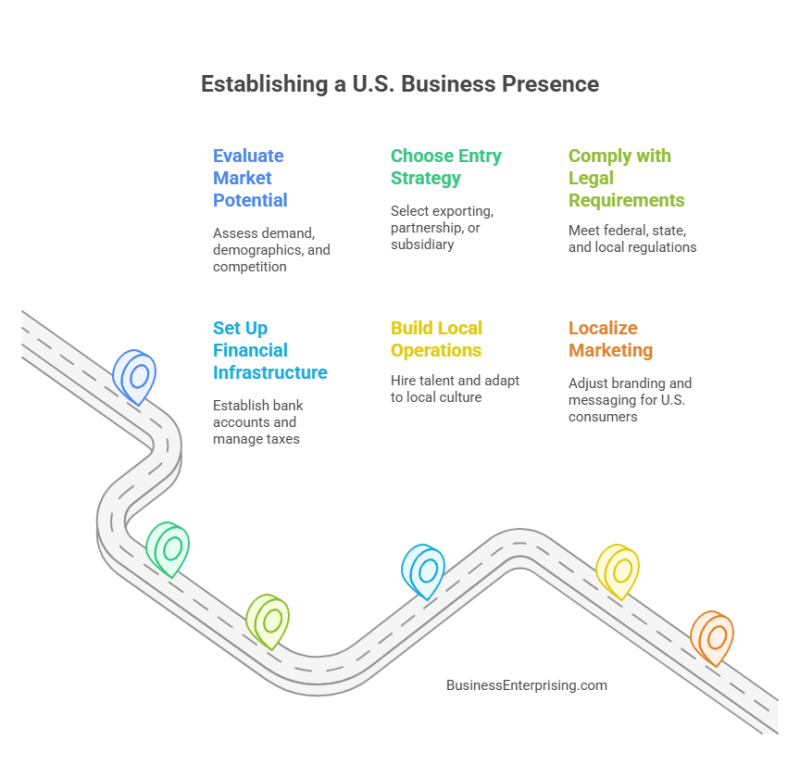
The U.S. market is large and diverse. However, that scale comes with competition and complexity. You must assess your industry, pricing, and target audience with precision. Additionally, you should understand the regional differences that may impact your product or service.
Legal, tax, and operational requirements also vary. Therefore, you must prepare for local compliance at every level. Building early relationships with service providers can help you avoid mistakes. However, you still need to stay involved in each decision. Your long-term growth depends on the structure you build now.
Marketing matters as much as logistics. You must adapt your message and branding to connect with American buyers. Additionally, digital channels like search and social media require a local touch. If you skip this step, your message may miss the mark entirely.
Establishing a U.S. presence takes commitment, not luck. However, if you move step by step, the process becomes more manageable. Each decision should move you closer to sustainable, measurable growth. With the right strategy, you can turn a market entry into a long-term foothold.
Evaluating U.S. Market Potential for Your Business
Before establishing a U.S. presence, you must first evaluate the market potential. Start by researching overall demand for your product or service. Focus on specific regions where similar offerings already perform well. Additionally, analyze purchasing behavior to see if customers are actively seeking what you provide.
You should also study the demographics that align with your brand. Age, income, education, and lifestyle choices will help you understand buying patterns. Therefore, narrowing your target audience makes your planning more effective. Without this clarity, your marketing budget may spread too thin across irrelevant segments.
Competitor analysis offers more than insight into who you’re up against. It helps you spot gaps and test pricing benchmarks. Use free tools to research keywords, traffic estimates, and digital engagement. This data can guide your online marketing plan and brand positioning. However, avoid copying your competitors outright. Use them to refine your edge.
Additionally, industry trends matter. You should assess how your category is growing, shrinking, or shifting. Pay attention to regulatory changes or evolving customer expectations. These factors could affect your timeline or product features.
Many entrepreneurs overlook demand validation. Instead, prioritize data over assumptions. Use online surveys, focus groups, or sales tests to measure interest. This reduces costly errors once you enter the market.
By examining demand, demographics, and competition, you lower your risk and make smarter choices. Establishing a U.S. presence requires more than forming an entity. It takes clear research and objective thinking. With the right data, you move from guessing to knowing—and that sets you up for smarter growth.
Choosing the Right Market Entry Strategy
Choosing how to enter the U.S. market affects every part of your business. Each approach comes with different costs, risks, and benefits. You should select a strategy based on your goals, resources, and timeline. Some methods require less capital but offer limited control.
Direct exporting is often the first option. It allows you to sell to U.S. customers without setting up a local entity. This reduces overhead but limits your control over marketing and service. However, it works well if your product is simple and logistics are manageable.
Partnerships and joint ventures provide local insight and faster entry. You gain shared resources, which can lower risk. However, you give up some control and must align with your partner’s decisions. Therefore, it helps to define terms clearly before you begin.
Franchising works well if your concept is proven and easily replicated. It allows for rapid expansion with minimal capital. However, it requires strong systems and consistent support. Without those, your brand may suffer across locations.
Additionally, setting up a local subsidiary offers the most control. You can build your brand, hire directly, and own the customer experience. However, this path costs more and takes time. It suits companies with long-term growth plans and deeper resources.
Establishing a U.S. presence is not one-size-fits-all. You must weigh speed against control and cost against opportunity. Each strategy has trade-offs. By comparing them carefully, you improve your chance of success while avoiding unnecessary risk.
Legal and Regulatory Considerations
When establishing a U.S. presence, you must comply with legal requirements at multiple levels. These include federal, state, and local rules. The process begins with choosing a legal structure. Most foreign-owned businesses form a corporation or limited liability company. Each option offers different tax rules and liability protections.
A corporation is often preferred for attracting investors. It separates personal and business finances more clearly. However, LLCs provide more flexibility in management and fewer formalities. Therefore, your long-term plans should guide the decision.
Additionally, foreign owners need to consider visa and immigration rules. You may need a visa to live or work in the U.S. Your role in the company will help determine which visa applies. These requirements depend on ownership level, job duties, and country of origin.
You must also follow local laws. Each state has different rules for business registration, taxes, and licenses. For example, some states require annual reports or franchise tax payments. City or county rules may add more requirements depending on your location.
At the federal level, tax compliance matters. You may need to file IRS forms as a foreign-owned entity. Additionally, you must understand reporting rules for money transfers and ownership disclosures. These rules affect how your profits are taxed and reported.
Complying with legal and regulatory rules takes time and attention. However, doing it right avoids penalties and delays. You protect your business by staying informed and keeping records organized. Establishing a U.S. presence starts with knowing the rules and applying them from day one.
Taxation and Financial Infrastructure
When establishing a U.S. presence, you must understand how taxes and financial systems work. U.S. tax laws apply at both the federal and state level. Foreign-owned businesses may be taxed on income earned in the U.S. Additionally, you might need to file separate forms for foreign ownership or international income.
Choosing the right structure affects how you pay taxes. Some states have lower tax rates or fewer filing requirements. However, most will require annual returns and franchise fees. Therefore, compare state tax rules before selecting your business location.
Opening a U.S. business bank account helps you receive payments and manage daily operations. Most banks require a U.S. company formation, a tax ID, and a local address. Therefore, prepare your documents before applying. You may also need to visit the bank in person.
Once your account is open, focus on building credit. Business credit affects your ability to borrow or secure payment terms. Additionally, paying bills on time and using a business credit card can help. Over time, this makes it easier to access funding or negotiate with suppliers.
International businesses must also manage currency transfers. You’ll need to move funds between countries while limiting fees and timing risks. Consider using a foreign exchange service or multi-currency account. However, always track transactions carefully to stay compliant with financial reporting rules. Financial systems in the U.S. are structured but accessible. By setting up the right accounts and understanding tax rules, you strengthen your financial base. That stability supports long-term growth and smoother operations.
Building Local Operations and Talent Acquisition
Building local operations is an important step when establishing a U.S. presence. Your first decision involves choosing where to operate. Some states offer lower taxes or easier logistics. However, others may give you access to better talent or suppliers. Therefore, weigh costs against business priorities before selecting a location.
Hiring talent comes next. You must decide whether to hire employees or use contractors. Employees offer stability but add complexity to payroll and compliance. Contractors give you flexibility but require clear contracts. Additionally, worker classification rules vary by state and must be followed carefully.
Once you start hiring, you’ll need a system for payroll. Most companies use payroll software or hire a provider. This keeps you compliant with wage laws and tax filings. However, you still need to track hours, benefits, and withholding accurately. Mistakes here can lead to costly penalties.
Adapting to local work culture also matters. U.S. employees may expect open communication, clear expectations, and flexible schedules. Therefore, adjust your internal processes to fit. You should also provide written policies that explain roles, conduct, and time off. This builds trust and reduces confusion.
Additionally, suppliers and service providers may expect fast decisions and reliable payment terms. You’ll need systems that support local expectations. This includes standard contracts, response times, and invoicing tools. By aligning your operations with U.S. norms, you become easier to work with and more credible.
Establishing a U.S. presence means more than opening a location. It requires building a team and running daily operations that reflect local standards. Doing so helps you gain traction faster and build lasting business relationships.
Marketing and Brand Localization
Marketing to U.S. consumers requires more than translation. You must adjust your brand and messaging to fit local habits and expectations. Establishing a U.S. presence means speaking the way your target customers think. However, you don’t need to abandon your core identity. You just need to localize the way it’s presented.
Start by reviewing your brand voice. Americans tend to prefer direct, confident, and benefit-focused messaging. Therefore, simplify your language and focus on value. Additionally, use visuals and taglines that align with cultural references your audience recognizes.
Your digital presence must also reflect local norms. A U.S.-based website should include local contact details and familiar formats. Additionally, adjust spelling, payment systems, and customer service hours. These details create trust and comfort with your brand.
SEO helps you get discovered. Use tools to find keywords U.S. users search for and create content around those terms. However, focus on quality over quantity. Localized blogs, guides, and FAQs show you understand what your audience needs.
Social media also plays a large role. U.S. users engage on platforms like Instagram, LinkedIn, and TikTok, depending on your niche. Therefore, tailor your content for each channel and post consistently. Additionally, influencer marketing can speed up your reach. Partner with creators who speak to your target market and fit your brand style.
Marketing and brand localization take planning and feedback. However, the payoff is a stronger connection with your audience. By adjusting your messaging and digital strategy, you make establishing a U.S. presence more effective and sustainable.
Conclusion
Establishing a U.S. presence takes more than setting up an office or selling online. It requires preparation, commitment, and local knowledge. You must evaluate your market fit, choose the right entry model, and comply with legal standards. Each step builds a stronger base for long-term results.
Additionally, you need to build operations that reflect local expectations. Hiring the right people and running smooth systems help you grow with fewer obstacles. However, growth also depends on visibility. That’s why tailored marketing, strong branding, and localized content make such a difference.
Therefore, take time to build the right foundation. Think about your budget, goals, and timing before making any major decisions. Each step adds complexity, but it also brings opportunity. You gain new customers, more exposure, and access to one of the largest markets in the world.
Planning ahead allows you to avoid common mistakes. Additionally, it gives you room to test what works and change what doesn’t. That flexibility helps you respond faster to shifts in the market or customer behavior.
By addressing compliance, strategy, hiring, and branding early, you increase your odds of success. You also make it easier to adjust when things don’t go as planned. Establishing a U.S. presence isn’t fast, but it is possible with the right strategy.
Take each step seriously, ask smart questions, and adapt quickly. That combination will move you forward with purpose and confidence. Over time, the small decisions you make now will shape your long-term success in the U.S. market.



